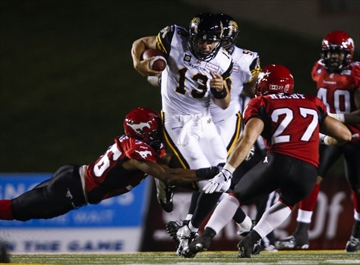Among the factors in Dan LeFevour getting the start for Saturday night-at-Mac is the same one that first earned him significant playing time last year.
Establishing the running game.
It was when Hamilton instituted the run-first "LeFevour Package" in the fifth game last Canadian Football League season — which, not uncoincidentally, they won — that the Ticats really began to take shape.
Defenders had to respect LeFevour, and rookie tailback C.J. Gable, and had to keep one eye on the run even when Henry Burris was back in the game.
The Ticats ended up fourth in the league in rushing, at just over 100 yards per game, mostly by Gable and the quarterbacks. Gable was fourth-leading rusher in the league with 782 overland yards, and added another 600 via pass, many of those short tosses, known in football parlance as "long hand-offs."
And the Cats reached double figures in wins for the first time in more than a decade.
Today, the Cats are dead last in the league in rushing with 70 yards per game and Gable, with just 57 yards on 17 carries, is ranked 18th individually.
Oh, and they are 0-3 for the first time in seven years, despite holding the game in their hands the past two outings.
And don't even get us started on opposing defences pinning their ears back, pawing the ground like a bull in a Bugs Bunny cartoon, then storming at the quarterback without the slightest worry that the Cats will counter the overenthusiasm with a blow-by-it run.
We'll leave most of the blame for the 17 sacks on the offensive line and will concede that this is a sack-crazy year because of disrupted offensive lines in most cities, but a credible run setup is one route out of Sackville.
A good, basic, run game is also an enabler for things that should eventually be an integral part of the Hamilton offence — reverses, options, counters and the like — given the versatility and speed they've sought in their past two recruiting classes. Not much of any of that is present at the moment because they have to be built on the platform of a believable running game.
While the CFL is an aerial league, thank the football gods, there is still room for the ancient adage that the run can, and often does, set up the pass.
"I think it is important," LeFevour said Thursday. "You've gotta establish the run game so they're not able to do the same thing every time against you."
The Cats tried to establish Gable's running presence last week in Calgary but it went nowhere, literally, with a woeful six yards on eight carries. But he's one of the most explosive players in the league, so they have to go back to that well until they come up with a full pail. They've got to make an impact athlete an impact athlete.
"He's our biggest playmaker, so we have to," LeFevour agrees. "He's one of the best playmakers in the league."
The offence isn't the only unit that contributes to the success of the run game, although it plays the biggest role. The defence must not concede many early scores because a deficit tends to curtail the run game, and special teams have to make sure the Cats aren't pinned deep in their own end, where defences know a team's first-down tendency is to run, and are prepared for it.
We'll sign off here with a numerical observation from 2013: In the games in which the Ticats rushed for 100 yards or more, they were 8-2, and one of those losses came in the season opener when Gable's late drop cost them a victory. And they had nearly 100 yards (95) during another win.
In the CFL, the pass may be the heart of the matter, but the run still matters and the Cats have to find it.
Right away.

